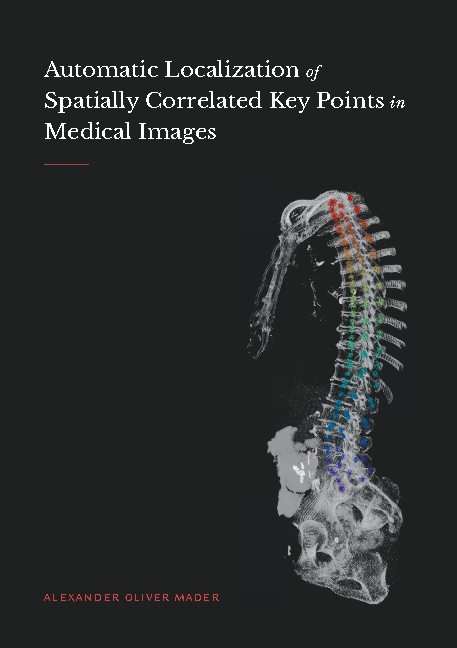
Automatic Localization of Spatially Correlated Key Points in Medical Images
Seiten
2021
BoD – Books on Demand (Verlag)
978-3-7534-8006-0 (ISBN)
BoD – Books on Demand (Verlag)
978-3-7534-8006-0 (ISBN)
The task of object localization in medical images is a corner stone of automatic image processing and a prerequisite for other medical imaging tasks. In this thesis, we present a general framework for the automatic detection and localization of spatially correlated key points in medical images based on a conditional random field (CRF). The problem of selecting suitable potential functions (knowledge sources) and defining a reasonable graph topology w.r.t. the dataset is automated by our proposed data-driven CRF optimization.We show how our fairly simple setup can be applied to different medical datasets involving different image dimensionalities (i.e., 2D and 3D), image modalities (i.e., X-ray, CT, MRI) and target objects ranging from 2 to 102 distinct key points by automatically adapting the CRF to the dataset. While the used general "default" configuration represents an easy to transfer setup, it already outperforms other state-of-the-art methods on three out of four datasets. By slightly gearing the proposed approach to the fourth dataset, we further illustrate that the approach is capable of reaching state-of-the-art performance of highly sophisticated and data-specific deep-learning-based approaches.Additionally, we suggest and evaluate solutions for common problems of graph-based approaches such as the reduced search space and thus the potential exclusion of the correct solution, better handling of spatial outliers using latent variables and the incorporation of invariant higher order potential functions. Each extension is evaluated in detail and the whole method is additionally compared to a rivaling convolutional-neural-network-based approach on a hard problem (i.e., the localization of many locally similar repetitive target key points) in terms of exploiting the spatial correlation. Finally, we illustrate how follow-up tasks, segmentation in this case, may benefit from a correct localization by reaching state-of-the-art performance using off-the-shelve methods in combination with our proposed method.
Alexander Oliver Mader submitted this dissertation to the Faculty of Engineering at the Christian-Albrechts-Universität zu Kiel in fulfillment of the requirements for the degree of Doktoringenieur (Dr.-Ing.) in August 2020, and successfully defended it on March 29, 2021.
| Erscheinungsdatum | 16.04.2021 |
|---|---|
| Sprache | englisch |
| Maße | 155 x 220 mm |
| Gewicht | 403 g |
| Themenwelt | Informatik ► Theorie / Studium ► Künstliche Intelligenz / Robotik |
| Informatik ► Weitere Themen ► Bioinformatik | |
| Medizin / Pharmazie | |
| Schlagworte | Dissertation • Key point detection and localization • machine learning • Medical Imaging • Probabilistic Graphical Models |
| ISBN-10 | 3-7534-8006-1 / 3753480061 |
| ISBN-13 | 978-3-7534-8006-0 / 9783753480060 |
| Zustand | Neuware |
| Informationen gemäß Produktsicherheitsverordnung (GPSR) | |
| Haben Sie eine Frage zum Produkt? |
Mehr entdecken
aus dem Bereich
aus dem Bereich
Buch | Softcover (2024)
REDLINE (Verlag)
20,00 €
Eine kurze Geschichte der Informationsnetzwerke von der Steinzeit bis …
Buch | Hardcover (2024)
Penguin (Verlag)
28,00 €


